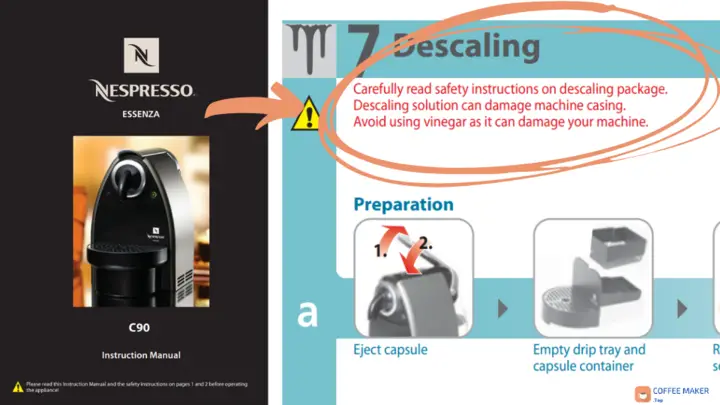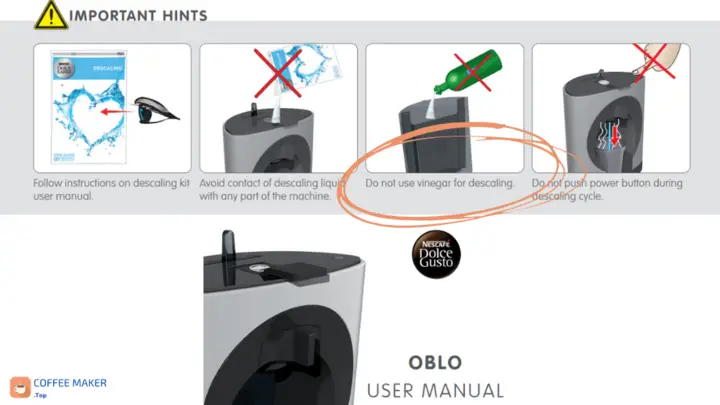When it comes to descaling our coffee machine, the first question we encounter is which descaling liquid to use. Whether it’s prompted by a notification from the machine or our maintenance routine, many brands of descaling liquids are available online, all designed to remove limescale from the machine’s internal water circuit.
However, some users may wonder if there’s a more natural and cost-effective solution, such as using white vinegar as a universal descaler.
With its high acetic acid content, white vinegar has been a popular choice for household cleaning and descaling worldwide for generations.
Given the availability and effectiveness of white vinegar, one might question whether it’s worth buying commercial chemicals to clean our coffee machine.
Is a commercial descaler or white vinegar better?
It’s true that coffee machines have been around longer than coffee machine descalers. Back in the day, before the market became as competitive and diverse as it is now, people used to descale their machines at home using white vinegar to remove the limescale buildup caused by water usage.
➡️ However, in my opinion, using specific descaling liquids designed for coffee machines is a more effective way to maintain and extend the life of your appliance. Nowadays, these products are readily available at low prices, and if you can find one specific to your coffee machine brand, even better.
That being said, if you care about the environment and already have white vinegar at home, purchasing a commercial descaler is unnecessary.
White vinegar can also do the job, but you’ll need to rinse your machine more thoroughly to avoid any vinegar smell or taste in your next cup of coffee.
In the following video, you can see a demonstration of how to descale a Nespresso with vinegar:
What do coffee machine brands say about the use of vinegar for descaling?
Many leading coffee machine manufacturers, particularly those producing coffee pod machines, market their own descaling liquids or tablets and explicitly advise against using vinegar. They even state in their user manuals that they cannot be held responsible for any damage caused by using vinegar in their machines.
For instance, let’s look at some excerpts from user manuals that explicitly prohibit the use of vinegar for descaling. In the instruction leaflet for a Nespresso Essenza, the manufacturer has highlighted in red that vinegar is harmful to the machine:

Here’s another example that illustrates this point. In the instruction manual for the Dolce Gusto Oblo, the Nestlé Dolce Gusto company explicitly forbids the use of vinegar:

The question that remains unanswered is why many brands discourage or even prohibit the use of vinegar for descaling. Is it because they want to sell their own descaling products, or is vinegar truly harmful to coffee machines?
While I don’t believe vinegar is inherently damaging, I recommend using official descaling liquids because the companies are not liable for any damage caused by home remedies.
The main issue with using vinegar for descaling is the risk of corrosion or degradation of the internal aluminium components of the machine.
However, if you thoroughly rinse the coffee maker after descaling with vinegar (up to two or three times, if necessary) and ensure that the inside of the water tank is properly cleaned, no harm should be done.
Of course, if your coffee maker has steel components rather than aluminium, there should be no risk. However, each case is different, and no universal rules apply to every situation. We can only provide information and encourage each user to act accordingly.
How to descale a Dolce Gusto with vinegar (video):
Alternatives to using vinegar in coffee machines
If you’re looking for a natural alternative to vinegar and commercial descaling products, consider using a citrus-based coffee machine descaling liquid instead of acetic acid.
One of the main concerns with using vinegar for coffee machine descaling is that its high acidity can potentially damage the internal pipes or leave a residual taste that affects future drinks.
If you’d like to make your own homemade descaling solution, I recommend using the juice of one or two lemons mixed with hot water.
Mix well with approximately one tablespoon of lemon juice per half a litre of water to make the solution. This solution is gentler and less aggressive than vinegar, making it safer for descaling your coffee machine.
The difference between cleaning and descaling
It’s important to differentiate between descaling and cleaning, two different procedures. Although vinegar is commonly used to remove dirt and burns in household appliances, it is not the same as descaling.
To descale your coffee machine with white vinegar, it is recommended to use it in the same proportion as the descaler recommended by the manufacturer. For example, if the user manual instructs you to mix 250 ml of descaler with 250 ml of water, you should use 250 ml of white vinegar and 250 ml of water.
You should follow the manufacturer’s recommended steps for descaling, with one exception: when using white vinegar, you should double or triple the recommended rinses. This will help to eliminate any vinegar taste or smell in your next cup of coffee.
For more specific instructions on how to descale your particular coffee machine, check the user manual provided by the manufacturer.
Descaling process of a coffee machine with white vinegar
This process will remove limescale build-up inside your coffee machine and clean the tank.
- Start by removing the tank and thoroughly rinsing it. Use a cloth or kitchen paper to remove any visible dirt or debris.
- Next, mix one part of white vinegar with one part of cold water and fill your machine’s reservoir with this solution.
- Run the coffee machine as if you were making coffee, but without coffee.
- After a few minutes, turn off the coffee machine and let the vinegar solution sit in the reservoir for about 15-20 minutes. The vinegar will effectively clean the tank and the internal water circuit during this time.
- Finally, empty the tank and fill it with clean water. Run the machine again, without coffee, to rinse any remaining residue. It’s best to do this twice to ensure a thorough rinse.
By cleaning your coffee machine with vinegar, you can effectively remove any debris or sediment that may have settled in your coffee machine.
Cleaning the coffee maker with white vinegar and baking soda
Another method that can be used as an alternative to the previous one is a milder solution that combines baking soda, water, and white vinegar in a ratio of 50%-25%-25%. This mixture is gentler and less aggressive than vinegar alone, which may make it a more desirable option for some people.
It’s important to note that the effectiveness of this method depends on the condition of the machine’s pipes and the area being cleaned. Therefore, it may not work well in all situations, and results may vary.